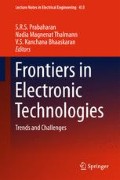Abstract
This paper discusses the role of sensors and actuators in Human–Computer Interaction and Virtual Reality. We first introduce the need of sensory input and output and the user senses stimulation. We then present two experiences of immersive games with a comparison of the techniques 20 years ago and today and also discuss the importance of vision-based hand tracking. The main part of the paper is dedicated to haptic and tactile feedbacks with 4 different case studies: haptic feedback using a haptic workstation, a wearable system for mobility improvement of visually impaired people, a system for enhancing pilot performance, and actuators to feel the wind. Finally, we survey a few smart jackets with sensors and actuators.
Access this chapter
Tax calculation will be finalised at checkout
Purchases are for personal use only
References
I.E. Sutherland, The ultimate display. Proc. IFIPS Congr. 2, 506–508 (1965)
H.G.M. Pakala, I. Khan, K. Raju, Sensors and actuators integration in embedded systems. ACEEE Int. J. Netw. Secur. 02(02) (2011)
http://phys.org/news/2015-11-glove-cold-virtual-reality-apps.html#jCp
T. Molet, A. Aubel, T. Çapin, S. Carion, E. Lee, N. Magnenat Thalmann, H. Noser, I. Pandzic, G. Sannier, D. Thalmann, Anyone for tennis?, Presence, vol. 8, no. 2 (MIT, 1999), pp. 140–156
A. Aristidou, J. Lasenby, Motion capture with constrained inverse kinematics for real-time hand tracking, in Proceedings of the 4th ISCCSP (2010), pp. 1–5
Cyberglove 2, http://www.cyberglovesystems.com/
H. Liang, J. Yuan, D. Thalmann, Resolving ambiguous hand pose predictions by exploiting part correlations. IEEE Trans. Circ. Syst. Video Technol. 25(7), 1125–1139 (2015)
L. Ge, H. Liang, J. Yuan, D. Thalmann, Robust 3D hand pose estimation in single depth images: from single-view CNN to multi-view CNNs, in Proceedings of IEEE Conference on Computer Vision and Pattern Recognition (CVPR’16) (2016)
R. Ott, F. Vexo, D. Thalmann, Two-handed haptic manipulation for CAD and VR applications. Comput. Aided Des. 7(1), 125–138 (2010)
C. B. Zilles, J. K. Salisbury, A constraint-based god-object method for haptic display, in Proceedings of the IEEE/RSJ International Conference on Intelligent Robots and Systems, vol. 3 (1995), pp. 146–151
A. Peternier, D. Thalmann, F. Vexo, Mental vision: a computer graphics teaching platform, in Proceedings of the 2006 Edutainment Conference (2006), pp. 223–232
C.W. Borst, A.P. Indugula, Realistic virtual grasping, in Proceedings of the 2005 IEEE Conference on Virtual Reality (VR’05) (IEEE Computer Society, Los Alamitos, 2005), pp. 91–98
S. Cardin, F. Vexo, D. Thalmann, Wearable obstacle detection system for visually impaired people, in VR Workshop on Haptic and Tactile Perception of Deformable Objects, Hannover, Germany, December 2005
W. Karlen, S. Cardin, D. Thalmann, D. Floreano, Enhancing pilot performance with a symbodic system. in Proceedings of the Engineering in Medicine and Biology Society (EMBC) (IEEE, 2010), pp. 6599–6602
Solar Impulse (2010), http://www.solarimpulse.com
W. Karlen, C. Mattiussi, D. Floreano, Sleep and wake classification with ECG and respiratory effort signals. IEEE Trans. Biomed. Circ. Syst. 3(2), 71–78 (2009)
S. Cardin, F. Vexo, D. Thalmann, Vibro-tactile interface for enhancing piloting abilities during long term flight. J. Robot. Mechatron. 18(4), 381–391 (2006)
GPS Lingerie, http://bit.ly/Xhog4
R. DeVaul, M. Sung, J. Gips, A. Pentland, MIThril 2003: applications and architecture, in Proceedings of the Seventh IEEE International Symposium on Wearable Computers (2003), pp. 4–11
U. Anliker, P. Lukowicz, G. Troester, S.J. Schwartz, R.W. DeVaul, The WearARM: modular, high performance, low power computing platform designed for Integration into everyday clothing, in Proceedings of the 5th IEEE International Symposium on Wearable Computers (2001)
L. Buechley, M. Eisenberg, J. Catchen, A. Crockett, The LilyPad Arduino: using computational textiles to investigate engagement, aesthetics, and diversity in computer science education, in Proceedings of the SIGCHI Conference on Human Factors in Computing Systems (CHI) (2008), pp. 423–432
Studio5050, http://5050ltd.com/modules
https://www.kickstarter.com/projects/597538543/the-worlds-best-travel-jacket-with-15-features-bau
https://www.indiegogo.com/projects/thermaltech-the-first-solar-powered-smart-jacket-solar#/
http://creativity-online.com/work/vodafone-smart-jacket/46067
X. Righetti, S. Cardin, D. Thalmann, F. Vexo, Immersive flight for surveillance applications, in Proceedings of the IEEE Symposium on 3D User Interfaces (2007) pp. 139–142
A. Pirhonen, S. Brewster, C. Holguin, Gestural and audio metaphors as a means of control for mobile devices, in Proceedings of the SIGCHI conference on Human Factors in Computing Systems: Changing Our World, Changing Ourselves (ACM, 2002), p. 298
Acknowledgements
This research is supported by the Being Together Centre, a collaboration between Nanyang Technological University (NTU) Singapore and University of North Carolina (UNC) at Chapel Hill. The Being Together Centre is supported by the National Research Foundation, Prime Minister’s Office, Singapore under its International Research Centres in Singapore Funding Initiative.
Author information
Authors and Affiliations
Corresponding author
Editor information
Editors and Affiliations
Rights and permissions
Copyright information
© 2017 Springer Nature Singapore Pte Ltd.
About this paper
Cite this paper
Thalmann, D. (2017). Sensors and Actuators for HCI and VR: A Few Case Studies. In: Prabaharan, S., Thalmann, N., Kanchana Bhaaskaran, V. (eds) Frontiers in Electronic Technologies. Lecture Notes in Electrical Engineering, vol 433. Springer, Singapore. https://doi.org/10.1007/978-981-10-4235-5_4
Download citation
DOI: https://doi.org/10.1007/978-981-10-4235-5_4
Published:
Publisher Name: Springer, Singapore
Print ISBN: 978-981-10-4234-8
Online ISBN: 978-981-10-4235-5
eBook Packages: EngineeringEngineering (R0)

